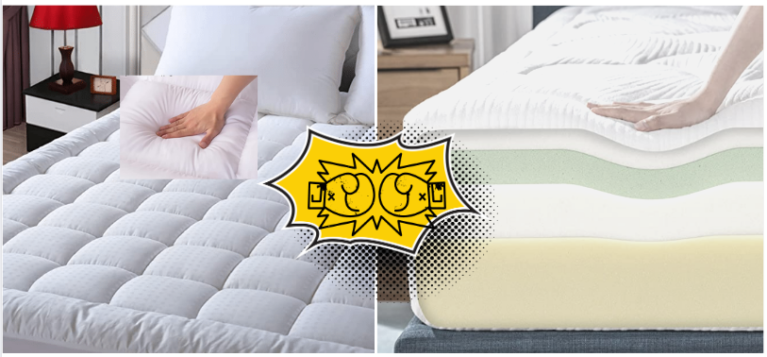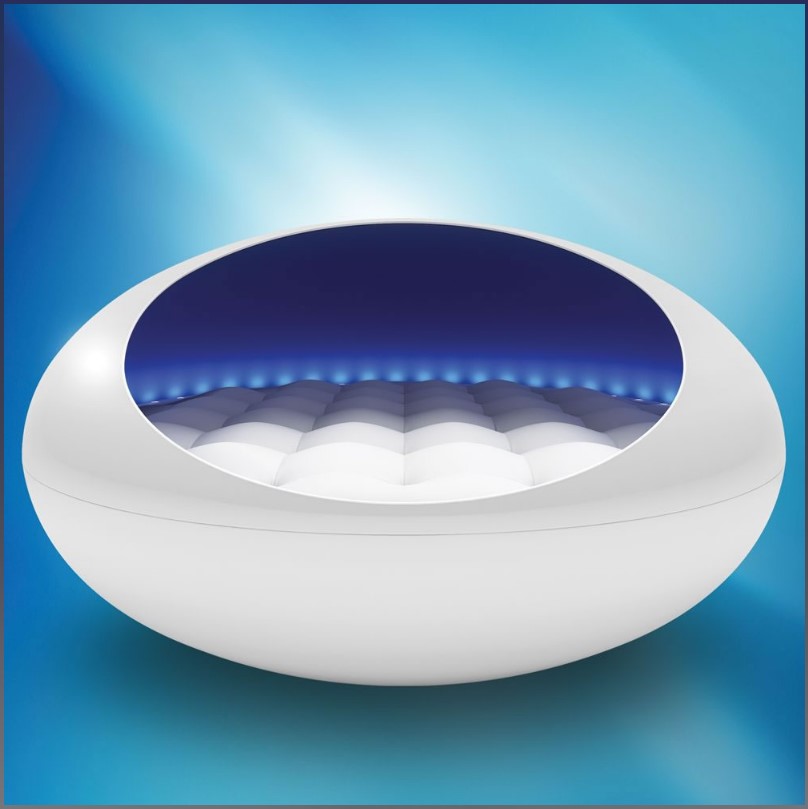There’s a lot of debate when it comes to pillow top mattresses Vs memory foam mattresses. Which one is better? Is one more comfortable than the other? What are the benefits of each?
There are advantages to both pillow top and memory foam mattresses, but in the end, it comes down to personal preference. Some people prefer the softness of a pillow top mattress, while others find it too flimsy. Some people love the support that memory foam provides, but others find it too stiff.
Read on to know the pros and cons of pillow top and memory foam mattresses and understand which one suits your needs.
If you are only interested in the overview skip right to the end. You can read the conclusion and view our easy-to-understand table which lists the pros and cons for each.
What are pillow top mattress
Pillow top mattresses add an extra layer of cushioning added to the top of a regular mattress (typically an innerspring). The pillow top is made from thick foam, latex, or fiberfill materials. It is designed to provide extra comfort, support, and pressure-point relief. Pillow tops come in various thicknesses depending on the desired level of comfort and support.
Pillow top mattresses are usually softer than other types of mattresses because they offer more cushioning for your body as you sleep. This makes pillow tops ideal for people who prefer soft beds. It also makes them ideal for those with joint pain, back problems, or other physical ailments that require additional cushioning and pressure relief.
Pillow tops also come with different levels of firmness depending on the type of material used in the pillow top layer. For example, pillow tops with a firmer foam layer may be better suited for people who need more support while pillow tops made with softer fibers may be better suited for people who want a softer bed. It all comes down to individual preferences and needs when it comes to choosing pillow top mattress type and firmness level.
Types of pillow top mattress
There are two types of pillow top mattresses: the Euro pillow top and the regular pillow top. The main difference lies in how the extra pillow top padding is attached to the mattress.
The Regular pillow top has a clear gap between the added padding and the original mattress comfort layer. The gap is quite visible and not as firmly attached. The regular pillow tops are typically softer than Euro tops and also look more rounded. this is due to the soft fluffier nature as well as the lack of full mattress edge stitching.
The Euro pillow top (also called Euro Tops) on the other hand has the extra padding layer stitched in under the mattress cove itself. So, there is no clear gap visible and the pillow top cushioning is firmly attached to the main mattress. Due to this, the Euro Tops look flatter than the regular pillow tops and can be stacked neatly. Euro pillow tops typically use firmer materials than regular ones. Euro Tops are generally more durable and provide better edge support.

Pros and cons of pillow top mattresses
Pillow top mattresses can provide exceptional comfort and support. Lets look at some of the other pros and cons that they come with.
Pros:
• Pillow top mattresses are incredibly comfortable due to their pillow-like layer of cushioning. This pillow-like layer provides additional comfort by conforming to the shape of your body. This helps reduce pressure points and relieve discomfort throughout the night.
• These mattresses absorb movement very well. This makes them great for couples who might be disturbed by one another’s movements in bed. The pillow-top layer helps to dampen motion transfer. So, you won’t be disturbed by your partner’s tossing or turning during the night.
• Pillow top mattresses are generally priced lower than the memory foam ones. The prices can range from 300-3000$
Cons:
• Pillow top mattresses can be difficult to move around. They tend to be heavier than other mattress types due to their added pillow-like cushioning layer. This can make changing sheets or moving furniture more of a hassle than usual.
• Over time, pillow tops may become less supportive as their pillow-top layer compacts with continued use and loses its original plumpness and thickness. Regularly rotating your pillow top mattress can help prevent this issue from occurring too quickly, however! Overall, they tend to be less durable than memory foam mattresses. They typically last 6-8 years Vs 10 or more for memory foam. However, a few manufacturers have started giving 10-year warranties.
• Also, pillow tops may not provide enough support if you suffer from chronic back pain or other orthopedic issues since they tend to be softer than memory foam models.
• Lastly, some people may find that pillow tops retain heat more easily than traditional mattress types. This is due to the added cushioning layer trapping air inside it. Which, makes it harder for heat to escape during hot summer nights or when sharing a bed with someone else who tends to generate more body heat during sleep!
What are memory foam mattresses?
Memory foam mattresses are among the most popular types of mattresses available on the market today. It was originally developed in the 1970s to cushion astronauts during take-off and landing. Memory foam is a type of polyurethane foam that is designed to mold to the shape of your body hence, providing superior support and pressure relief.
Most memory foam mattresses today are often constructed with layers of varying densities for enhanced comfort and contouring support. The unique properties of memory foam come from its special construction. Memory foam consists of a combination of petroleum-based chemicals, along with vegetable oil derivatives and other additives that give it its distinctive feel.
Memory foam mattresses typically have higher density levels than traditional pillow-top mattresses while providing good support as well as a cushioned feel. They have improved weight distribution, which helps reduce strain on pressure points like hips and shoulders. Memory foam also has an open-cell structure that increases breathability for added comfort.
Types of memory foam mattress
Memory foam mattresses come in all shapes and sizes, so it’s important to consider the type that best suits your needs. The most common types of memory foam mattresses are traditional, gel-infused, and hybrid.
Traditional memory foam mattresses
Traditional memory foam mattresses are the original design and have been around for decades. They consist of multiple layers of varying densities of foam and typically have a pillow top cover for added comfort. Traditional memory foam mattresses provide superior support and pressure relief. But, they can retain body heat more than other types due to their higher density levels.
Gel-infused memory foam mattresses
Gel-infused memory foam mattresses feature gel beads or gel-infused foam that helps regulate temperature while you sleep. As well as providing exceptional support and pressure relief, this type of mattress is designed to keep you cool throughout the night.
Hybrid memory foam mattresses
Finally, hybrid memory foam mattresses combine two or more different types of material such as latex, or coils. Hybrid mattresses are often constructed with layers of varying densities for maximum comfort, support, and durability. They also have an open-cell structure that enhances breathability for added temperature control during sleep.
Pros and cons of memory foam mattresses
Memory foam mattresses offer several advantages when compared to pillow top mattresses. They also have a few disadvantages which should be considered before making your final choice
Pros of Memory Foam Mattress
- They are more supportive, providing superior contouring and pressure relief for a more restful sleep. They also provide optimal spinal alignment at the same time.
- Memory foam mattresses also have an open-cell structure or gel-infused layers which helps to improve air circulation throughout the mattress, keeping them cooler.
- Additionally, memory foam mattresses are designed to reduce motion transfer between partners due to their unique construction and elasticity.
Cons of Memory Foam Mattress
- Memory foam mattresses lack the soft pillowy feel of the pillow top mattresses which have a plush sleeping surface that many people find comfortable.
- Moreover, pillow top mattresses are generally less expensive than memory foam models. This makes them accessible to more people on a budget. Memory foam mattresses can cost between 600-5000$ which makes the higher-end ones among the pricier options available today.
- Since these are made from petroleum based raw materials, there have been complaints about off-gassing of harmful chemicals.
- Memory foam mattresses sometimes have a strong smell when newly opened at home. However, the smell generally subsides over time.

How to decide pillow top vs memory foam mattress, which is right for you?
When it comes to choosing a mattress, pillow top and memory foam are two of the most popular options. It is important to consider your own needs when making your decision between pillow top versus memory foam mattresses. Both of these mattress types have pros and cons. So, choose carefully for the pros which are useful to you against those that don’t matter.
Think about what qualities are most important for you in a mattress. Do you want something softer, more supportive or more breathable? Do you suffer from allergies or need something with therapeutic properties? When considering pillow tops vs memory foam mattresses, keep these factors in mind so that you can find one that best meets your needs.
Points to consider when choosing your mattress:
- Soft & Plush Vs supportive hugging feeling
- How cool does it feel: Breathable & Gel infused versions will feel cooler
- Is the top fabric hypoallergenic and protects against allergies
- Budget: Look for a good quality mattress that matches your budget
- Warranty & Trial period
- Is mattress smell or off-gassing important to you?
Once you have pinpointed exactly which qualities are essential for the mattress you’re looking for, begin researching different brands and models available within pillow tops or memory foam categories. Then compare the prices and features side-by-side. Make sure to read reviews from other customers who have already used the product. This will give you an idea of how well it stands up over time as well as if there were any major issues with it before buying it!
Finally, take into account your budget when choosing pillow top versus memory foam mattresses. Both types are available at a range of price points. So, do not overspend by buying something too expensive if there isn’t much difference between two models in terms of the quality or features offered. After considering all these factors carefully, use this information to make an informed decision about pillow top vs memory foam mattresses. By following these steps you will be able to find one that feels just right for a great night’s sleep!
Which one should you choose
Overall, pillow tops and memory foam mattresses both have advantages and disadvantages when it comes to comfort and support. Some people like the plush springy feel of a pillowtop others like the contouring and body hugging feel of memory foam. There no right or wrong so, choose the type that best suits your needs. Consider your sleeping habits as well as your budget before making a decision on which one is best for you.
Go through the table below and decide what matters to you. Ultimately, the best way to decide which mattress is right for you is to try them out for yourself. Go to a store that carries both types of mattresses and lay on them for at least 20 mins each. See which one feels most comfortable to you. That’s the one you should buy!
| Feature | Pillow Top Mattress | Memory Foam Mattress |
|---|---|---|
| Comfort | Good comfort, soft pillowy feel | Excellent comfort, body contouring |
| Supportiveness | Not as good as memory foam for pain relief but depends on pillow top thickness and material The top brands are know to be great for hip and other pains. | Good support for back and pain relief depending on mattress firmness |
| Cool sleep | Breathable, cool | Regular memory foam is hot and traps heat Cooling gel infused memory foams are cool |
| Motion Isolation | Depends on many factors. Innersprings do not help with isolation. Thickness of middle layers and pillow top material can help | Excellent motion isolation |
| Price | More affordable 300 – 1200 $ | More expensive 800 – 4000$ |
| Durability | Last 6-10 years Pillow top mattresses can lose their plush and soft feel within a few years. | Last for 10-15 years Memory foam is tougher and more durable Note: Lower quality memory foams can sag early. Avoid these! |
| Smell & Off gassing | Some pillow tops come with memory foam in the pillow part which can cause the same issues though to a lower extent | Memory foam often has complaints of smell and off gassing. Look for a CertiPUR-US® certification which means it has les VOOC and so lesser smell and off gassing. |
Frequently Asked Questions
Which is better for allergies: Memory foam or pillow top?
Memory foam mattresses are often favored by those with allergies because they are made from a synthetic material that is naturally resistant to dust mites and other natural allergens. This does not mean that pillow tops do not protect from allergens. Pillow tops frequently come with hypoallergic covers and filling.
A clear answer has become difficult these days due to the various improvements in technology and hybrid style mattress construction. Do your research and read the mattress details as well as check with the store salesperson for details before committing to a purchase.
Is a memory foam mattress hot to sleep in?
Memory foam mattresses are slightly hotter than innerspring mattresses which are more breathable. There are cooler gel-infused memory foam mattresses available as well.
Pillow-top mattresses provide an additional layer of cushioning that can make them slightly warmer than the basic innerspring mattress without a pillow top. However, these might still be cooler than a cheaper or basic memory foam mattress.
Can I flip a pillow top mattress?
Flipping a pillow top mattress can cause the pillow top to become flattened and less supportive over time. The pillow top provides a layer of cushioning that prevents the mattress from becoming too hard and uncomfortable. When flipped, this pillow top layer compresses more quickly and does not offer the same type of support as when it’s left alone.
In short, no don’t flip a pillow top mattress. You should rotate it head to toe occasionally to even out the wear.
Which is better for back pain: Memory Foam or Pillow top mattress?
Memory foam mattresses are well-known for providing superior support, as they conform to the body and help distribute weight evenly, which can alleviate pressure points in the neck, shoulders, and back. If you have back pain make sure that the memory foam is not too thick and mattress is firm. Also, ensure that the mattress mentions orthopedic support as a feature.
Pillow tops provide an extra layer of cushioning on top of traditional innerspring coils, giving them a softer surface. That may be best suited to those who don’t require substantial support but still want a comfortable night’s sleep. Some of the top brands provide good support for hip & back pain.
Other articles you might like
- How to choose a mattress thats right for you
- The right thickness for your latex mattress is..
- Investment or ripoff: Are expensive mattresses worth it?
- Know About Pillow Top Mattresses Pros And Cons
- Is the Sleepyhead mattress topper any good?



